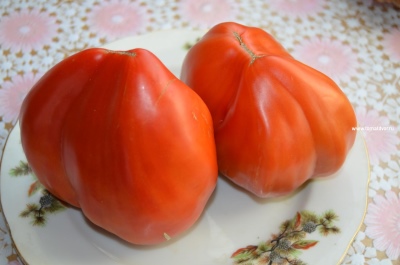
- Authors: old family variety, Kupino, Novosibirsk region
- Category: grade
- Growth type: indeterminate
- Appointment: fresh consumption
- Ripening period: mid-season
- Ripening time, days: 110
- Growing conditions: for greenhouses
- Bush size: tall
- Bush height, cm: up to 180
- Ripe fruit color: deep red
The desire of many gardeners to acquire the newest types of planting material is not entirely reasonable. Time-tested samples can also give a very good effect. Tomato Scallops red is able to confirm this rule with all credibility.
Breeding history
This variety is one of the oldest types. It was created in the city of Kupino, in the Novosibirsk region. There is no other information on this score.
Description of the variety
Red scallops are a bright representative of indeterminate tomatoes. The plant forms tall shrubs reaching 1.8 m. An ordinary thin sheet is characteristic of them. Cultivation is possible both in open ground and in a greenhouse. Growing under a film cover is allowed.
The main qualities of the fruit
Ripe berries have a rich red tint. In this they are fully consistent with the name. Fruits of Red scallops are large and can "pull" by 0.4 kg. Their shape resembles a heart, but at the same time a little more rounded. 3-5 fruits appear on the cluster, containing a small amount of seeds.
Taste characteristics
The pulp of the fruit is fleshy and juicy. Sweet taste is typical for her. Some tasters even say that this culture belongs to the dessert group of tomatoes, it is so pleasant to use. Processing and canning is not justified.
Ripening and fruiting
This is a mid-season variety. On average, it will ripen in 110 days. However, in any case, weather conditions can make significant adjustments. Leaving more than 2 stems is not recommended. Violation of this rule sharply reduces the fertility of the culture.
Yield
The fertility of the variety is quite high. Summer residents relatively easily manage to collect 4 kg of berries from 1 plant. With careful, well-thought-out agricultural technology, this indicator can be increased a little more. Proper care is critical. Fee for 1 sq. m can reach 8-10 kg.
The timing of planting seedlings and planting in the ground
Sowing of seeds is carried out approximately 60-65 days before the expected time of transplantation into open land or a greenhouse. This is usually done in the middle or last decade of March. This approach allows you to plant the main bushes in the first half of June.

Growing tomato seedlings is an extremely important process, because it largely depends on whether the gardener can harvest at all. All aspects must be taken into account, from seedbed preparation to planting in the ground.
Landing scheme
For 1 sq. m place 3 bushes. The arrangement is chosen at your own discretion, guided by personal experience. The holes are bred to such a distance that the bushes do not get confused.

Growing and care
It is imperative to form red scallops. In this case, you can leave both 1 and 2 stems. The choice is determined by personal gardening preference. Loose soft soil is highly recommended. It is pre-sieved.
Other measures are typical for all tomatoes. Digging is useful to combine with the introduction of mineral fertilizers. For subsequent feeding, you can use both mullein and special mixtures. And you can also use superphosphate and ash. The bushes should be tied vertically.
The bushes must be earthed. Despite decent immunity, protective treatments are highly relevant. During the hot season, watering can be done twice every day. Harvesting must be done on time. Overripe berries are extremely poorly stored.




A plant needs different micronutrients at each stage of growth. All fertilizers can be divided into two groups: mineral and organic. Folk remedies are often used: iodine, yeast, bird droppings, eggshells.
It is important to observe the rate and period of feeding. This also applies to folk remedies and organic fertilizers.
Disease and pest resistance
The variety can withstand the effects of most pathologies. Fruit cracking under normal conditions is practically impossible. The tobacco mosaic virus and the causative agent of verticillus have practically no negative effects. The danger can be:
aphid;
whitefly;
bear.


Resistant to adverse weather conditions
Red scallops - drought-resistant tomato. You just need to take into account that this is a light-loving plant. The plant can survive low temperatures well. However, with them, real fertility is noticeably reduced.It is for this reason that greenhouse cultivation is most preferred.

























































































